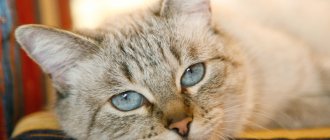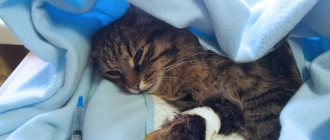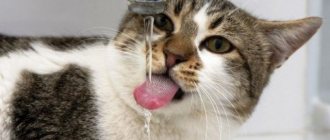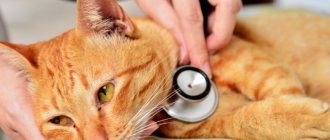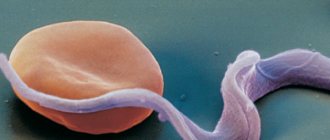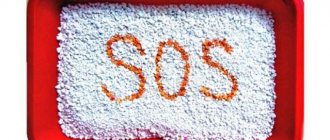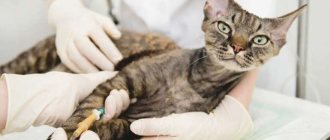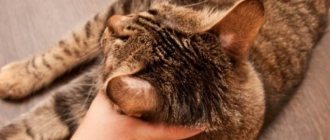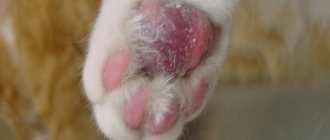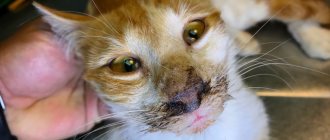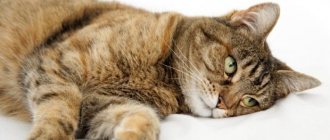The kidneys play an important role in the process of eliminating waste products from the cat's body. Disruption of the functioning of these organs can lead to serious consequences for the health and life of the animal. It is important to carry out timely diagnosis when the first alarming symptoms of kidney disease appear. Kidney disease in cats, symptoms and treatment - about this in our article.
Kidney disease in cats: symptoms and treatment
Kidney functions
The kidneys perform the following functions:
- remove water and salts;
- remove toxic substances formed in the body or included in medications;
- maintain constant metabolism;
- maintain a constant blood reaction.
Location of the kidneys in a cat
Common diseases
Kidney diseases pose a great danger. When there are serious problems, there is always the possibility that the animal may die.
Table. Common kidney diseases in cats
| Name of the disease | Emerging problems |
| Chronic failure | The gradual destruction of an organ, as a result of which the activity of the entire organism is disrupted. Stays with the animal for its entire life. Pet owners can only carry out constant maintenance therapy, avoiding exacerbation of the disease. The impetus can be any unfavorable factors (hypothermia, inflammatory diseases, metabolic disorders, etc.) |
| Acute failure | Unforeseen inflammatory process. There is a violation of the functions performed by organs. It develops rapidly and poses a greater danger than the chronic form. Common causes of the problem: heart disease, shock, drop in blood pressure, urolithiasis |
| Pyelonephritis | An inflammatory process of a bacterial nature. A common source of the problem is diseases of the genitourinary system |
| Nephritis | An inflammatory disease that affects the glomeruli, tubules, and interstitial renal tissue |
| Hydronephrosis | Enlargement of the pyelocaliceal system, destruction of the renal parenchyma. As a result, a pathological process develops, blood circulation is disrupted, and the outflow of urine worsens. All functions of the kidney cease to be performed properly. The problem can be primary or secondary. In the first case, the cause is the presence of congenital pathologies (for example, ectopia of the ureter). In secondary hydronephrosis, problems arise due to systemic diseases (urolithiasis, tumors, etc.) |
| Nephrosclerosis | The tissue of part of the kidney or the entire organ is replaced by connective tissue. There is a gradual death of kidney cells - nephrons. As a result, the organ greatly decreases in size, shrinks and hardens. |
The structure of a cat's kidney
Causes of the disease
global $ads_google; //data-ad-slot=”2475549904″ $ads_google = empty($ads_google) ? false : true; ?> if ($ads_google == false) {?>
$ads_google = true; ?> } ?>
Owners of some breeds need to be more careful, as the incidence of kidney disease is higher in Persian and Angora cats. But often this is an acquired disorder that occurs for a number of reasons:
- as a result of decreased blood circulation and urine flow to the kidneys;
- high blood pressure levels;
- oncology;
- kidney stones create obstruction;
- poisoning by a number of medicinal and non-medicinal drugs;
- severe oral diseases;
- incorrectly selected diet with a large amount of phosphorus or high protein content.
The following can be said about the acute form. In prerenal acute renal failure, the cause may be shock after bleeding, poisoning, dehydration, or heart failure. There will be a drop in pressure and impaired circulation in the bloodstream of the kidneys. The causes of renal acute renal failure are called bacterial infections, inflammations and infections, poisoning with poisons and chemicals.
In postrenal acute renal failure, urolithiasis develops due to blockage of the urinary tract.
Causes of problems
Often it is not possible to determine the reasons why the disease occurred. The most common reasons:
- age (cats from 7 years of age are most susceptible to diseases, so it is necessary to conduct their annual full examinations: blood test, urine test, ultrasound, blood pressure measurement);
- genetic predisposition (the presence of similar problems in representatives of a certain breed to which the animal belongs);
- congenital anomaly;
- ecology;
- infectious diseases;
- systemic diseases;
- poisoning;
- injuries;
- poor nutrition;
- negative processes in the urinary canals (the problem is more common in cats, since their canals are longer and narrower than those of cats).
Cats over 7 years of age are most susceptible to diseases, so it is necessary to conduct their annual full examinations.
Predisposing factors that provoke kidney diseases:
- lack of fluid consumed by the animal;
- drinking contaminated water;
- excess salt contained in the feed;
- Exceeding the required amount of sugar in the diet;
- frequent feeding of meat and fish;
- large mass;
- lack of weight;
- keeping in dampness, in drafts;
- sedentary lifestyle;
- untimely urination (occurs when an animal is periodically unable to go to the toilet on time due to closed doors or dirty litter);
- oral problems.
Kidney diseases in cats and kittens
Types of kidney failure
1 classification:
— acute — with acute renal failure it is possible to restore kidney function;
- chronic - kidney tissue degenerates into connective tissue. The process is irreversible; the kidneys do not restore function.
Classification 2 (according to causes):
- to renal. The cause of kidney dysfunction is impaired blood supply due to severe dehydration or prolonged exposure to anesthesia.
- after renal. It occurs against the background of an abnormal outflow of urine caused by urolithiasis (blockage of the urinary tract).
- actual renal failure. Occurs after poisoning with a toxic substance and is a consequence of chronic diseases (in particular, chronic kidney inflammation).
Symptoms of kidney diseases
Attention! The first signs of disease appear when the organ is affected by 70% or more. For this reason, early diagnosis plays a huge role and significantly increases the chances of a positive outcome.
The main points that may appear at the onset of the disease are:
- weight loss;
- reluctance to eat;
- strong thirst;
- frequent urination;
- strong smell of urine;
- ammonia odor, most pronounced in the morning;
- decreased activity;
- faded wool;
- digestive disorders.
Signs of kidney disease in a cat
Symptoms appear at the following stages:
- fluid loss;
- frequent urination;
- painful sensations;
- increased protein levels in the urine;
- inflammations, ulcers;
- cracks in the mouth;
- weakness, drowsiness;
- pale gums;
- refusal to eat;
- nausea, vomiting;
- bowel disorders;
- weight loss;
- retinal disinsertion.
Kidney disease in cats: symptoms
The following symptoms indicate kidney disease:
- Appetite decreases or the cat refuses food.
- The urine becomes cloudy and has an unpleasant odor. The test reveals protein, pus (pyuria) or blood (hematuria).
- Signs of intoxication increase, vomiting and diarrhea develop.
- The mucous membranes become bluish.
- Urination becomes painful. The pet arches its back and screams.
- If the outflow of urine is not impaired, polyuria develops - an increase in the volume of urine and the frequency of trips to the tray.
- If urination is difficult due to obstructions in the canals, a frequent urge to urinate is noted.
- The animal changes its habit of going to bed in a warm place. Prefers cold, which reduces pain.
Different types of diseases are characterized by the following additional symptoms:
- a creeping gait on half-bent legs, abdominal pain are characteristic of pyelonephritis;
- lumbar pain, fever, hematuria suggest glomerulonephritis.
Diagnostics
The main diagnostic method that provides complete information is a urine test. An additional diagnostic method is ultrasound examination. During an ultrasound, the kidneys and urinary ducts are examined for the presence of pathological processes, stones, and sand.
Symptoms of urinary tract diseases in cats
If the results of a blood test and ultrasound reveal problems that require additional examination, the following are prescribed:
- biopsy;
- blood analysis;
- genetic research;
- virus detection;
- pressure measurement.
Based on the final diagnostic results, conclusions are drawn about the type of kidney disease, the stage of the disease and its treatment options. The most effective drug regimen is prescribed.
Video - Diagnosis and stages of chronic renal failure in cats
Diagnosis of kidney problems in cats
Based on clinical symptoms, the owner may suspect that the cat has kidney pain, but only a specialist can determine the type of disease. The veterinarian collects anamnesis and prescribes a general urine test.
If necessary, blood is examined for creatinine and the ratio of serum protein fractions, and an ultrasound is also performed. Bacteriological culture identifies the causative agent of infection, as well as its sensitivity to antibiotics.
Treatment
General treatment of kidney diseases is carried out in the following areas:
- Elimination of factors and diseases that caused the problem.
- The use of medications prescribed by a veterinarian, taking into account the age, weight, nature of the disease, and stage of the animal’s disease. Systematic use of correctly selected drugs will help stabilize the condition and prevent active progress.
- Use of antibiotics. Antibiotics are prescribed if an infectious process occurs. Antibacterial drugs help suppress the activity of harmful microorganisms that were the source of the development of the pathological process.
- The use of droppers. Special solutions are introduced into the animal’s body, which allow the correction of pathological processes. When dehydrated, the required amount of fluid is restored.
- Compliance with the prescribed diet. Animals with kidney problems need to eat special food. The level of nutrients in these feeds corresponds to the required norm.
Treatment can be carried out using droppers
Kidney failure
It is always necessary to promptly contact a specialist for diagnosis and treatment. In the acute form, it is important to quickly identify the factor that triggered the development of the process and eliminate this factor. For example, if you have urolithiasis, it is impossible to relieve the symptoms of kidney failure without treating this problem. The main methods of treatment used in the acute form:
- Intravenous injections (“Sulfokamphokai”n). Helps restore water balance and relieve symptoms of intoxication.
- Diuretics (Temisal, Diacarb). When there is insufficient amount of urine excreted relative to the fluid consumed.
- Symptomatic treatment: for vomiting - antiemetics (Papaverine, Cerucal, Enterosgel), for elevated glucose levels - insulin, etc.
- Hardware hemodialysis. Hardware blood purification, which allows you to prolong the life of the animal.
- Surgical intervention. If all of the above treatment methods are ineffective, the diseased organ is removed and a healthy one is transplanted.
The drug "Eufillin"
Treatment for the chronic form includes:
- Regular checks (blood, urine). If deviations are detected, additional diagnostics are carried out and the prescribed systematic treatment is adjusted.
- Use of infusion therapy (administration of solutions).
- Taking vitamin and mineral preparations (Polidex, Beafar, Anivital Feliimmune).
- Use of nutritional supplements (“Feliimmune”).
- Application of phytotherapeutic methods. Ready-made mixtures and preparations based on medicinal herbs are highly effective along with a low level of side effects.
- Hardware hemodialysis.
- Surgical intervention.
"Feliimmune" to support the immune system of cats
The prognosis in the chronic and initial stages of the disease is quite favorable. If you follow doctors' recommendations regarding diet and use of prescribed medications, the animal's life can be extended for a considerable time.
Important! In the acute form of the disease, the prognosis is unfavorable. The likelihood of death is very high.
Pyelonephritis
Treatment regimen:
- painkillers (“No-shpa”, “Baralgin”, etc.);
- perinephric block;
- a course of antibiotics (“Penicillin”, “Carbenicillin”, “Amoxicillin”, etc.);
- a course of sulfonamides (“Sulfadimethoxine”, “Sulfen”, etc.);
- chemical diuretics (“Diacarb”, “Eufillin”);
- herbal diuretics (rose hips, calendula);
- droppers.
The drug "Diacarb"
Nephritis
Treatment regimen:
- chemical diuretics (“Temisal”, “Eufillin”);
- herbal diuretics (lingonberry leaf, bearberry);
- sedatives for heart failure (digital infusion, strophanthus infusion);
- iron preparations and vitamins (“Cyanocobalamin”, “Ferroglukin”, “Campolon”);
- strengthening agents - for diarrhea;
- laxatives - for constipation.
"Cyanocobalamin"
Hydronephrosis
For minor damage:
- catheterization;
- washing the urethra and bladder.
In more serious cases, surgery is performed.
Nephrosclerosis
Treatment is aimed at eliminating the underlying disease. Applicable:
- cardiac drugs (cardiac glycosides, drugs with potassium, anticoagulants);
- diuretics (“Eufillin”, “Temisal”, “Diakarb”);
- glucose therapy;
- laxatives, antiseptics (for intestinal intoxication);
- antibiotics.
Diuretic Eufillin
Medicinal feed as a method of prevention
During the period of treatment of pets for kidney diseases, the rules of nutrition are followed. Feed little by little 4 times a day. There must be water constantly.
The diet is balanced, low in salt. Monitor the protein content in food.
Dry and canned food is of high quality. Preference is given to specially developed medicinal ones.
They prepare natural products: boiled chicken, rabbit meat, vegetables, porridge.
Attention! You cannot constantly feed your cat dry store-bought food. She begins to become dehydrated and have kidney problems.
Prevention
Preventing problems in cats is much easier than treating them later. To maintain your pet’s health, the following recommendations must be followed on an ongoing basis:
- Do not allow the animal to sleep on a cold floor, lie in a draft, etc. Under the influence of low temperatures, vasoconstriction occurs and the blood supply to organs is disrupted. Hypothermia immediately has a negative impact on the functioning of the genitourinary system. The inflammatory process that began as a result of hypothermia can serve as an impetus for the further development of diseases.
- Protect from heat. In the heat, the animal consumes an increased amount of fluid, the load on the kidneys increases significantly.
- Monitor your cat's diet. The animal must receive the necessary set of vitamins and microelements during feeding. It is important not to limit the diet only to meat, fish, and dry food. Food should be balanced and varied. It is necessary to give your pet as little fatty, salty foods as possible. Eliminate from the diet all food that is harmful to the animal’s stomach: sausages, baked goods, pasta, fried foods, etc.
- Give the animal only high-quality water - clean, but not boiled. It is recommended to use filtered water. Unsuitable water can serve as a provoking factor, since the animal’s kidneys are very sensitive to its quality.
- Monitor the availability of water. A lack of fluid leads to the fact that all its reserves are consumed, and the accumulated breakdown products are not removed from the body in the required quantities.
- Keep your pet active.
To avoid health problems, give your animal only high-quality water.
Important! Active movements contribute to good functioning of the urinary system, so animals with an active lifestyle have a significantly lower risk of problems.
How are acute renal failure and chronic renal failure treated?
Kidney failure in cats is incurable. Unlike hepatocytes (liver cells), nephrons do not regenerate. Treatment is aimed at increasing possible life expectancy and maintaining its quality.
A sick pet will have to undergo regular tests and take medications to prevent its kidneys from failing. More detailed therapy will depend on the course of the pathology:
- Acute
. After identifying and eliminating the root cause, rehydration is carried out to eliminate the effects of dehydration. With the help of medications, the patient eliminates hemolysis (destruction of red blood cells) and relieves the consequences of poisoning. In especially severe cases, hemodialysis is prescribed. After inpatient treatment, the animal is sent home and put on a recovery diet.
- Chronic
. Without starting from the cause, doctors try to stimulate appetite with the help of a maintenance diet. Blood pressure and all metabolic processes are normalized. The consequences of anemia are eliminated with hematopoietic drugs (Ursoferran, Recormon, Hemobalance). More vitamins are added to the diet. Hemodialysis is mandatory.
Without finding out the root cause, it is impossible to stop the pathological process. Remission after symptomatic treatment will certainly end in relapse. Ultimately, the pathology will become chronic.
List of medications
It is impossible to say how long a pet will live before starting treatment. Life expectancy depends on the body's response to the medications used. The veterinarian may prescribe:
- glucocorticosteroids (Dexamethasone, Prednisolone, Methylprednisolone), suppressing immune reactions and relieving swelling;
- diuretics (Furosemide), laxatives (Lactusan, Duphalac) and antiemetics (Famotidine, Metoclopramide) drugs;
- potassium-containing drugs (Panangin), which replenish potassium levels;
- rehydration and nutritional solutions (Ringer's solution, glucose, Trisol, saline solution), eliminating the effects of dehydration and normalizing metabolic processes;
- drugs to lower blood pressure (Ramipril, Enalapril);
- detoxification (Liarsin, Sirepar, Enterosgel) and hemostatic (Vikasol, Ditsinon) drugs;
- antibiotics (Baytril, Enrofloxacin, Sinulox) that eliminate primary factors;
- cardiogenic drugs (Riboxin, Cocarboxylase, Sulfocamphocaine) that prevent ruptures in capillaries.
To restore appetite, the animal is forcibly administered nutrient mixtures hourly. Intestinal microflora is normalized with medications containing beneficial bacteria.
Self-selection of medications is unacceptable. The treatment regimen is developed based on the patient's diagnosis. The veterinarian can replace the listed drugs with others, expand or reduce the list.
Lifelong diet and care
Regardless of the form of the disease, treatment involves following a diet. You will have to stick to the new menu for at least six months. Returning familiar products immediately after eliminating symptoms is unacceptable, since the doctor makes this decision only on the basis of changes in the tests. If kidney damage is over 75%, the therapeutic diet is followed for life.
Dairy products, fatty meat and fish, salt, fish oil and caviar are prohibited. The abundance of phosphorus complicates the course of the disease, negatively affecting the condition of the bones and central nervous system. Its daily rate is reduced to 65-85 g per 1 kg of animal weight.
It is allowed to eat lean meats (chicken, rabbit, turkey), cabbage and carrots. Twice a week the cat is given boiled chicken hearts and liver. Meat is served boiled or raw. In the latter case, it is well frozen in the freezer to destroy all parasites. Offal is served strictly boiled after deep freezing. There should be no more than 4.5 g of protein per 1 kg of cat weight.
At high urea values (30 mmol/l), energy must be obtained from unsaturated fats and carbohydrates. Proteins are temporarily excluded. The patient is fed oat pancakes, pasta with vegetable oil and bread. A small amount of sugar is added to dishes.
Provide constant access to fresh water and feed your pet in small portions. Don't go hungry. When refusing food, hand feed the patient, administer liquid food through a syringe, or heat food before serving to enhance its flavor.
When dry feeding, it is recommended to choose medicated food labeled Renal. This product contains reduced protein and phosphorus and is available in the form of granules and mousse.
Avoid independent walks outside to protect your pet from injury and infection. Do not touch his stomach, as any touch will cause severe pain and aggravate the condition. Place the sick cat in a quiet and warm place, protected from outside noise and drafts.
Self-installation of an IV
To reduce the load on the kidneys, veterinarians prescribe subcutaneous infusions of saline. Sometimes saline solution is mixed with other drugs. The dosage, duration of the course and its repeated use are prescribed only by a veterinarian.
Sometimes infusions need to be done for a long time - up to a month continuously, if the condition of the kidneys is poor. Taking your cat to the veterinarian every day is not only expensive, but also dangerous for the animal’s health, since excess stress aggravates the situation.
Some owners call a veterinary nurse to their home, while others decide to carry out the procedure themselves. In fact, subcutaneous infusions are not that complicated, and mastering them is easier than it seems.
The dropper is placed at the withers, since this is where cats have the least nerve endings and the most space for fluid. The volume of a single infusion can range from 50 to 100 milliliters at a time. The vast majority of people with mustaches tolerate the procedure calmly.
It is most convenient to use the so-called “butterfly”: it is a short needle with a large cavity, it speeds up the administration of the drug. Protective “wings” do not allow the tip to slip out, even if the cat begins to struggle during the procedure. For large cats, a thicker needle is recommended, No. 18-19, for medium-sized cats – No. 20-21, for kittens – a needle No. 23.
The needle is equipped with a long “wire”, at the end of which a syringe is inserted. With such a device, making even large subcutaneous infusions is convenient and simple. The most that your pet may not like is that the saline solution tingles slightly, but it is not a painful sensation.
Have one person hold the cat while the other puts in an IV. Another option is to get a retainer bag. You need to strongly pull the skin on the upper part of the neck and insert the needle perpendicular to the spine. Inject the solution neither too quickly nor too slowly, then carefully remove the needle. The cat should not experience any blood or severe pain.
The danger of kidney disease
The danger is as follows:
- late diagnosis caused by the absence of symptoms in the initial stages;
- inability of kidney tissue to recover;
- the possibility of severe complications;
- the presence of a genetic predisposition factor in a number of breeds;
- males are prone to problems due to the structural features of their genitourinary system;
- high risk of death due to serious types of illnesses.
Only a veterinarian can prescribe the correct treatment
Kidney disease in cats: prognosis
The danger of the disease lies in late diagnosis. In the early stages, the disease does not manifest itself in any way, and clinical symptoms become noticeable when more than 2/3 of the renal parenchyma is affected.
Therefore, the prognosis ranges from cautious to unfavorable. Most cases of kidney disease affect older pets. But if the veterinarian’s requirements are met, the animal owner is able to maintain the pet’s health at a satisfactory level.
Enlarged organs
When pathology is identified, the underlying disease is treated. So, if the reason for the increase is inflammatory processes in them (pyelonephritis, nephritis), antibacterial therapy is prescribed. To eliminate dehydration and relieve symptoms of intoxication, droppers are prescribed. Complex therapy necessarily includes therapeutic nutrition. The animal is placed in a warm, dry place. Dehydration is not allowed.
Causes of the problem: congenital pathology, improper care, kidney disease.
Breeds with a predisposition to kidney disease
There are cat breeds in which the problem is hereditary:
- Persians. A common problem is polycystic kidney disease. Often the disease is detected even in kittens.
- Abyssinian breed. Predisposition to amyloidosis.
- Persian crossbreeds. They suffer from infantile polycystic disease.
Thus, the kidneys are a weak point for cats. In a number of breeds, the predisposition to kidney disease is hereditary. Compliance with preventive measures and timely identification of problems in an animal allows you to prolong its life.
